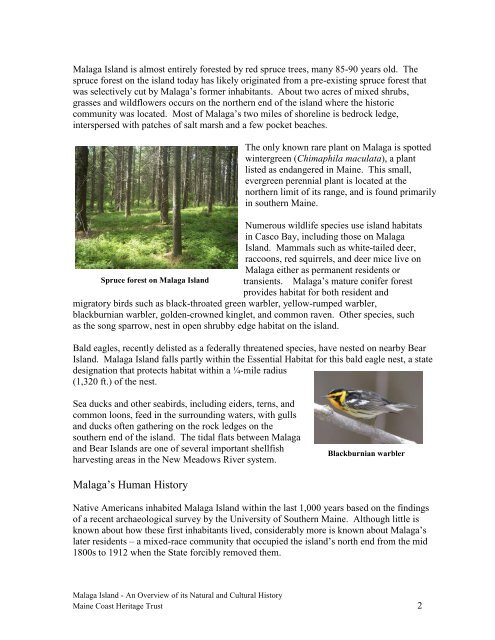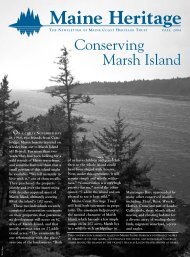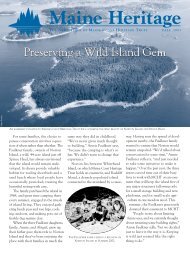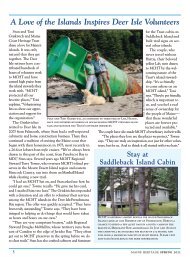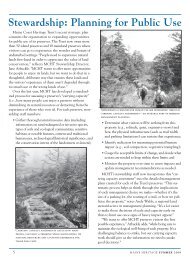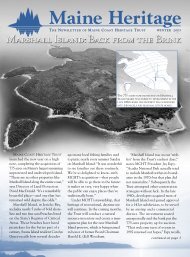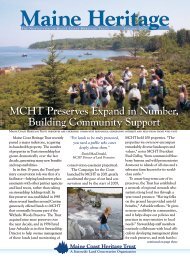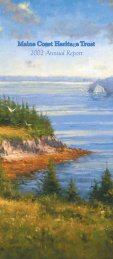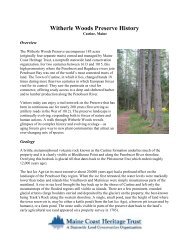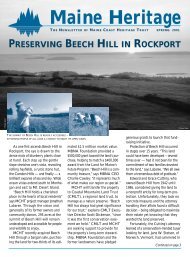Malaga Island - Maine Coast Heritage Trust
Malaga Island - Maine Coast Heritage Trust
Malaga Island - Maine Coast Heritage Trust
You also want an ePaper? Increase the reach of your titles
YUMPU automatically turns print PDFs into web optimized ePapers that Google loves.
<strong>Malaga</strong> <strong>Island</strong> is almost entirely forested by red spruce trees, many 85-90 years old. The<br />
spruce forest on the island today has likely originated from a pre-existing spruce forest that<br />
was selectively cut by <strong>Malaga</strong>’s former inhabitants. About two acres of mixed shrubs,<br />
grasses and wildflowers occurs on the northern end of the island where the historic<br />
community was located. Most of <strong>Malaga</strong>’s two miles of shoreline is bedrock ledge,<br />
interspersed with patches of salt marsh and a few pocket beaches.<br />
The only known rare plant on <strong>Malaga</strong> is spotted<br />
wintergreen (Chimaphila maculata), a plant<br />
listed as endangered in <strong>Maine</strong>. This small,<br />
evergreen perennial plant is located at the<br />
northern limit of its range, and is found primarily<br />
in southern <strong>Maine</strong>.<br />
Numerous wildlife species use island habitats<br />
in Casco Bay, including those on <strong>Malaga</strong><br />
<strong>Island</strong>. Mammals such as white-tailed deer,<br />
raccoons, red squirrels, and deer mice live on<br />
<strong>Malaga</strong> either as permanent residents or<br />
Spruce forest on <strong>Malaga</strong> <strong>Island</strong><br />
transients. <strong>Malaga</strong>’s mature conifer forest<br />
provides habitat for both resident and<br />
migratory birds such as black-throated green warbler, yellow-rumped warbler,<br />
blackburnian warbler, golden-crowned kinglet, and common raven. Other species, such<br />
as the song sparrow, nest in open shrubby edge habitat on the island.<br />
Bald eagles, recently delisted as a federally threatened species, have nested on nearby Bear<br />
<strong>Island</strong>. <strong>Malaga</strong> <strong>Island</strong> falls partly within the Essential Habitat for this bald eagle nest, a state<br />
designation that protects habitat within a ¼-mile radius<br />
(1,320 ft.) of the nest.<br />
Sea ducks and other seabirds, including eiders, terns, and<br />
common loons, feed in the surrounding waters, with gulls<br />
and ducks often gathering on the rock ledges on the<br />
southern end of the island. The tidal flats between <strong>Malaga</strong><br />
and Bear <strong>Island</strong>s are one of several important shellfish<br />
harvesting areas in the New Meadows River system.<br />
<strong>Malaga</strong>’s Human History<br />
Blackburnian warbler<br />
Native Americans inhabited <strong>Malaga</strong> <strong>Island</strong> within the last 1,000 years based on the findings<br />
of a recent archaeological survey by the University of Southern <strong>Maine</strong>. Although little is<br />
known about how these first inhabitants lived, considerably more is known about <strong>Malaga</strong>’s<br />
later residents – a mixed-race community that occupied the island’s north end from the mid<br />
1800s to 1912 when the State forcibly removed them.<br />
<strong>Malaga</strong> <strong>Island</strong> - An Overview of its Natural and Cultural History<br />
<strong>Maine</strong> <strong>Coast</strong> <strong>Heritage</strong> <strong>Trust</strong> 2


